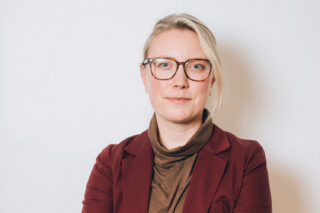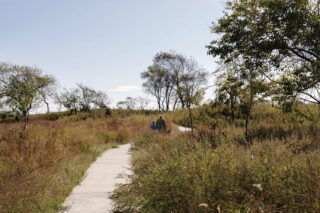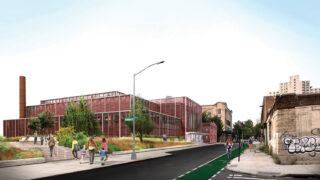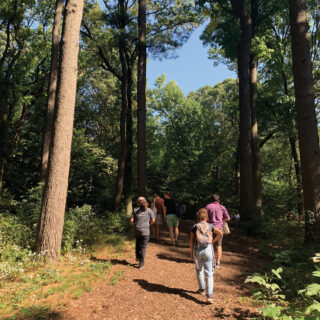Claire Weisz, FAIA, is an architect, urbanist, and educator. She is a founding principal of the award-winning firm WXY architecture + urban design, whose New York City-based practice focuses on innovative approaches to public space, buildings, and cities. WXY is a leader in advancing resilience practices at the intersection of architecture, planning, landscape, and urban design. Weisz is a fellow of the American Institute of Architects, and has taught design and planning studios at Yale University, New York University, Cornell University, and the City University of New York
The onslaught of atmospheric rivers and subsequent flooding, extreme heat waves, and record snowfall have offered a real-time demonstration of how interconnected our waterways, developed land, and urban settlements actually are. In 2024, as we continue to search for what resiliency and adaptation mean, it is incumbent on the design and planning communities to be part of changing the narrative from “the resilient city” to “the regenerative city.” In 2012, Superstorm Sandy reminded the world that coastal storms are among the world’s costliest and deadliest disasters when they strike urban centers. While disasters might be initiated by extreme weather events, human vulnerabilities that cross boundaries from aspects of environmental justice to social inequity—and from crumbling physical infrastructure to deteriorating social infrastructure—are what truly define the parameters of a disaster.
The occurrence of extreme weather events brings awareness of the need to adapt to our social, economic, and interdependent environmental systems. Responding to risks, rethinking ways we build, and adapting urban frameworks are all connected to the threats we share. But architects, and others who design and plan, hold both the pencil and the ability to bring people together.
Ten years ago, based on mid-range climate sensitivity models, scientists estimated in the journal Climatic Change that the U.S. faces a nearly $1 trillion price tag for sea-level rise and storm surge leading into the year 2100. This calculation does not include losses for economic output and intermediate expenditures for mitigation, resiliency, and adaptation interventions. Costs for those interventions—for New York City alone—were initially estimated by city officials to be $20 billion; updates, however, suggest that the actual cost with debt service, capitalized operations, and maintenance expenses could nearly double that figure. Indeed, the National Oceanic and Atmospheric Administration weighed in this year with its 2023-billion-dollar disaster report, showing that we didn’t have to wait until 2100: In the years 2017–2023 alone, 137 discrete billion-dollar disasters have killed at least 5,500 people. The scale of the challenge is daunting.
Despite updates to the Flood Insurance Rate Maps (FIRM) showing that the number of housing units in New York City in a 100-year flood zone was anticipated to nearly double (from approximately 35,000 to 67,000), this figure has only grown. The very real implications of these revised efforts translate into what will burden households as they strive to afford federal flood insurance. Per “PlaNYC: Getting Sustainability Done,” the 2015 FIRM 100-year flood zones are home to more than 400,000 residents. WXY’s work on PlaNYC estimates that 15% of the city’s land area is within the flood zone, and the total area of the 100-year floodplain is expected to grow 49% by 2050. The prospects seem even starker for managing any form of retreat when swimming against the tide of housing scarcity.
Urban ecology intertwines people and their environment. Now, with the lessons from a global pandemic and the realization that our climate is changing rapidly, the economic impact of extreme weather for New York and New Jersey in terms of public health, infrastructure, and commerce nearly defies calculation. Economics and statistics tell only part of the story, however; they do not speak to the tremendous emotional and psychological impacts on people, and the immeasurable losses of biodiversity in the natural environment. How do we understand this impact and discover other metrics? Valuing communities as stakeholders and investing the time and creativity in designing an engagement process can unearth and make the case for other important metrics that will point to regenerative approaches to addressing urban growth.
We are seeing that some of the hard engineering solutions, such as The East Side Coastal Resiliency (ESCR) Project, pay a high price in community disruption to achieve the change and protection desired. There is a growing fear of public investments further pushing people out of their homes due to rising property values. Many individuals and communities of color who contributed to the neighborhoods, businesses, and cultural hallmarks and traditions that emerged despite the burden of housing discrimination now face housing vulnerability and potential evictions, as real estate values and rents increase in areas being valued for their resiliency, according to the Georgetown Climate Center. Equally important, the creation of more natural habitats is being weighed against the cost of caring for parks and gardens. Even street trees, when lost, take a minimum of four years to replace, not including the growth of a new tree canopy. With more heat emergencies expected, shade is critical, but our planting and protection of trees and funding of green roofs, shade structures over public spaces, and similar measures have also not gained the momentum necessary. Whether hard or soft solutions are designed, planned, and funded, it is becoming clear that the things we have already built are valuable for the huge carbon investment they already embody.
Creating regenerative systems among people, land, water, and resources is a design problem. The interconnected role of the built environment and community solutions is emerging. If systems can be regenerative, then ecological value through ongoing maintenance will not be understood as the most important factor in design. Creating synergies between existing places and any new fixed solution to flooding, power, and protection will shift our focus.
If our urban oceans and waterfront cities are seen as the stable and reliable carbon market, then the result will be a vibrant ecosystem of interdependent scales that adapts the city and its systems to climate stress. It is the funding of remaking our cities into true regenerative systems that could shift how we value and support urban ecologies. While atmospheric scientists cannot predict when extreme climate and related weather events will strike or with what impact, it is inevitable that the next precedent-setting major storm event, whether a hurricane or Nor’easter, will hit the mid-Atlantic coast sooner rather than later. When these storms arrive, the economic burdens will continue to be borne by a diverse range of public and private stakeholders, with little relief in sight.
Advances in oceanography and artificial intelligence together offer a potentially unappreciated perspective on how to prepare for future events. The predominating sociotechnical bias has been to conceive of solutions on existing terra firma without thinking about coastal interventions. Coastal processes are controlled by wind, waves, ocean currents, and the highly predictable tides that move water and sediment day in and day out. These processes are responsible for the constantly changing landscape of the coast. In theoretical terms, the benefits of green infrastructure are infinite if you use the forces of nature. Likewise, the energy and materiality of natural systems are far more efficient and cost effective in their deployment than oil, concrete, and steel. However, the reality is that these interventions are not “natural,” as we generally conceive them. They are manipulations of material and ecological processes at the hands of humans. For these reasons, the design and scientific challenge is to explore the extent to which natural processes and energy dynamics may be harnessed for scaled interventions that serve either resilience or adaptive ends.
Public and private sectors have increasingly sought to find co-benefits that inure us to the advantage of environmental conservation, disaster risk reduction, and social and economic stability. But the reality is that only some neighborhoods benefit because of limited resources and tradeoffs. What could unite these often-oppositional forces is the universal risk from climate change, the disproportionate impacts, and the necessity to find efficiencies that bring interventions within the realm of feasible—if not possible.
The artificial archipelago off the coasts of New York and New Jersey—chronicled in the book Blue Dunes: Climate Change by Design, which I edited with climate adaptation scholar Jesse M. Keenan six years ago—distinguished itself among many other competing ideas at the time, not only by its scale and ambition, but also by its utilization of oceanographic science. Blue Dunes offers a lesson on how discipline-specific methods of scientists and designers intersect and diverge, but are otherwise resolved because of the desire to acknowledge that the challenges confronting society do not have a single solution grounded in a single discipline.
As a proposal, Blue Dunes was not just the engineering of sand and dredge for purposes of land reclamation. It progressively evolved into a much more complex design for landscape and architecture that had the dual task of accommodating natural and human ecologies, from the balancing of the conservation and commercialization of fisheries to the balancing of recreation with habitat preservation. With less turbulent waters, Blue Dunes raised the prospect that critical breeding grounds could expand regionally, or that surf conditions might change to the benefit of the fishing community.
But it is the young participants of Shore Corps at RISE, which focuses on environmental stewardship in Far Rockaway, who are a testament to the power of Dunes to lead the way. “I saw a change in the Shore Corps students in how they thought about the process of planning,” recalls Melina Chin, urban planning teaching assistant, RISE, Hunter College, and a 2021 Shore Corps alum. “Instead of wanting a perfect world, they thought about the people involved, the City Council members to reach out to, and community initiatives to build on. We were inspired to reframe things with a bigger, yet more detailed lens.” Ultimately, these and other concerns are all paradigms of shifting to the value of urban ecological thinking. What has happened and will happen for the Rockaways and its urban ecology highlights a broad array of potential benefits and innovations that could manifest themselves because of a vast industrial mobilization to address climate change.
For architects, landscape architects, and planners, in terms of spatial planning and design, it is not simply a matter of repurposing a previous generation’s coastal or other infrastructure. It is an opportunity to redefine our work as designers who seek to promote sustainable accommodation of a unified ecological state, whose boundaries weigh human and biophysical processes. Cities and their systems hold an embodied carbon investment that cannot be squandered. There is a strong interest today in figuring out how projects and plans can increase biodiversity and create better places to live and work. This is the only way we will change the currently carbon-intensive “resilient city” to a “post-fossil-fuel natural city” and be able to design and plan cities as urban ecology.
Note: Source materials for this essay include Barbara Neumann, et al., 2014; the New York City Mayor’s Office, 2013; and Blue Dunes: Climate Change by Design, editors Jesse M. Keenan and Claire Weisz, 2017; Greater Rockaway Community & Shoreline Enhancement Plan, WXY and RISE, 2021.














